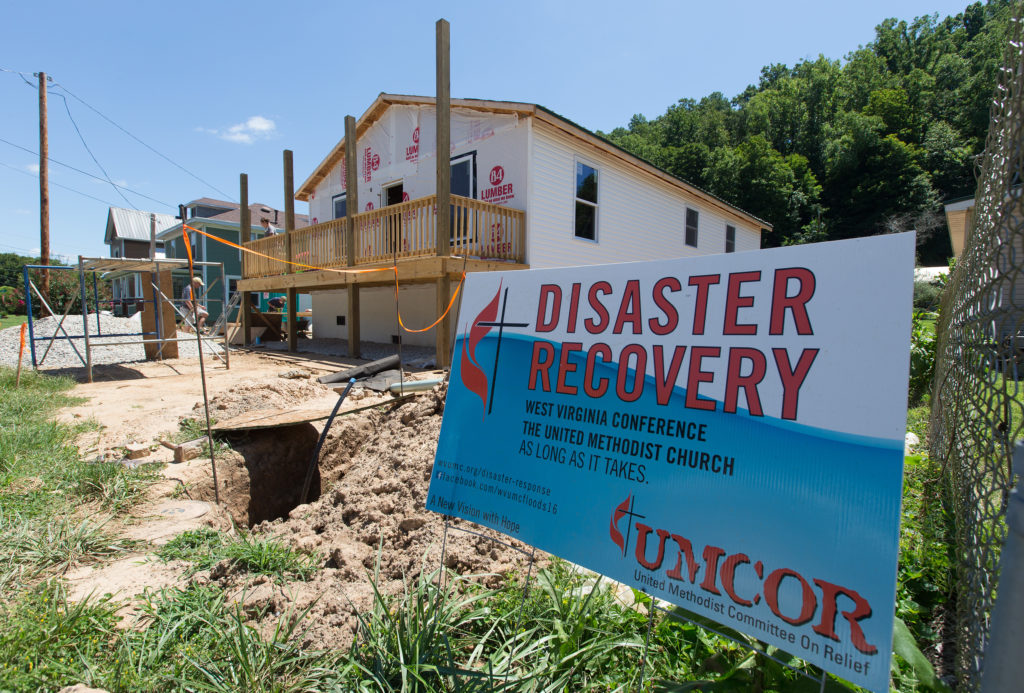
“The West Virginia Annual Conference is keeping faith with the United Methodist’s reputation of being early in and last out during disasters,” said J.F. Lacaria, executive director of the conference’s Long-term Recovery Team, when asked for an update regarding the June 2016 flood.
The disaster killed 23 people and impacted 44 of the state’s 55 counties.
“We’ve been operational since the fall of 2016,” Lacaria said. “In partnership with Mennonite and Amish construction teams, we are the last fully engaged faith-based organization working on long-term recovery.”
Lacaria said of the team: “We brought Jack Lipphardt out of retirement. We hired two case managers and two construction managers. They’ve all stayed in place.
“Alongside Dan and Sue Lowther, conference disaster response coordinators, and David Stilgenbauer, conference Volunteers in Mission coordinator, we continue to be present in all the affected counties, bringing hope in real time through construction and counseling, and giving witness to the restorative power of Christ through community,” he said.
“We celebrate the fact we are ‘soup-to-nuts,’ Lacaria added. “We can do any phase of recovery, from intake to case management to construction, to follow-up and sign-off. Others specialize in parts of that.
“We also have host sites for volunteers,” he said. “We can house them, feed them, find them work. The other half of that is, we meet clients, determine their needs, arrange for construction projects and direct volunteers.
“At the same time, we partner with a lot of other nonprofits. UMCOR is our strongest partner.” (UMCOR is the United Methodist Committee on Relief — the church’s global humanitarian aid and development organization.)
UMCOR has provided grants totaling $1.75 million, which includes a $1 million grant that is funding efforts through September. “UMCOR also helped us obtain a $5,000 grant from VOAD,” Lacaria said. (VOAD — the Voluntary Organizations Active in Disaster — brings organizations active in disaster response together.)
In addition, a total of $2.13 million in direct contributions has been received.
The Long-term Recovery Team also works closely with RISE WV, the state program intended to aid low-income West Virginians seeking assistance with repairs, replacement or reconstruction of their homes damaged by the flood.
As has been widely reported, RISE WV received a $140 million federal grant one year after the flood but did not start functioning until mid-2018.
Lipphardt said the Long-term Recovery Team’s advocacy and collaboration with the West Virginia National Guard and VOAD were key in getting RISE WV moving.
“With RISE moving forward, we could then use precious UMCOR funds and local donations to address recovery for people who need help but do not qualify for the federal assistance or to help complete a recovery for items not eligible such as furniture, kitchen, and household supplies,” Lipphardt said.
Lacaria said the Long-term Recovery Team has hosted 130 work teams and deployed 1,987 volunteers who have contributed labor valued at $1.5 million.
“We have made significant repairs to 120 homes, rebuilt 104 homes and replaced 27 homes,” he said. The two case managers are currently assisting 13 families plus 21 families who are still a part of the RISE WV recovery program.
Miranda Nabers, one of the case managers, works in the Elkview area. She is a member of St. Mark’s United Methodist Church in Charleston.
“We try to re-build hope, show that there’s still good in society.” Nabers said. “Hope is such a valuable thing! When you see the person you’re helping go out and help someone else in the community, that catches fire — it builds hope. It is important to see a community come together after a tragedy like this.
“It’s been an amazing journey for me,” she said. “Sometimes I’ve worked with young families, sometimes with elderly persons. I’ve helped figure out how we could help them recover or at least give them somewhat of a new normal. It might involve relocating or it might involve repairing a damaged house. For some people, it involves building all over again.
“If the first finished floor is six feet high, you have to think about what happens when the person gets older. They may need a ramp. We try to have a walk-in shower. We try to set people up for success. You have to think about factors other than just the here and now.
“One of the houses I worked on, grandma and grandpa had taken in three of the grandkids and another daughter moved in with them and she had three kids, too. They needed a four-bedroom house. Perry Miller and a Mennonite Disaster Service team from Hartville, Ohio, had plans for a four-bedroom house. I worked with Perry and the team on another house in Clendenin in late 2016. They brought their whole church down for a retreat on a Friday and they had the house under roof on Sunday. They made it a whole weekend event that included the community of Clendenin. They held a cookout one day and really embraced the community.
“It’s a wonderful part of this job: meeting so many people, seeing the connections,” Nabers said. “Clients say we’re a blessing. I say, ‘No, you are a blessing to me — to see what people do to stay with their family and preserve a sense of home. To have people trust us after going through so much uncertainty. It’s been an amazing, life changing experience for me.”
Said Lipphardt: “Creative partnerships can perform miracles.”
(Editor’s Note: Read the complete Long-term Recovery Team report on Page 100 of the Conference Workbook.)